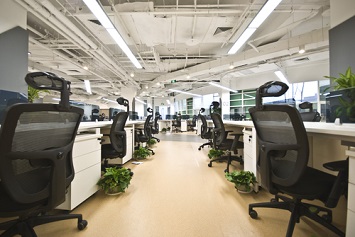Today’s employees – a workforce that includes many millennial and Generation Z workers who are notoriously independent and eschew loyalty to their companies in favor of flexibility – want to work remotely. Except when they don’t.
Contrary to impressions that the office is dead, a recent survey by Clutch found that 83 percent of American employees want to work in an office at least some of the time. Only 17% of employees would prefer working entirely remotely. Nearly three-quarters, or 73%, favor some combination of working remotely and in the office.
What’s clear is that not only do today’s employees want the option to work in an office, but they also want a workspaces to include perks.
Commercial real estate development companies hoping to position their properties as attractive to today’s businesses and employees need to keep three things in mind: amenities, private space and flexibility.
The Office Amenities Arms Race
Workers are no longer content with a nook in the office where they can park their laptop. Employees expect their physical office space to be an integral part of their overall job experience. In particular, they want in-office benefits, also known as amenities.
The commercial real estate sector is scrambling to meet modern employee expectations, reimagining workspaces with features once only associated with the home, hospitality or retail sectors.
This has fueled an “office amenity arms race,” as one architect involved in the industry dubbed it in a recent article in Curbed. Savvy property owners see them as a way to boost the value of properties and distinguish themselves from competitors. These amenities can include items such as fitness centers, games, golf simulators and elaborate rooftop decks.
“Making the office a healthy, fun, and social space encourages those who work remotely to want to come into the office,” said Leslie Saul, owner of Leslie Saul & Associates, an architect and interior design firm in Cambridge, Mass.
Don’t Offer Only Open Space
Open space is a trend some business and property owners have embraced as an efficient, collaborative and cost-effective way to provide space for workers who may not be in the office fulltime.
But there has been a backlash against office spaces that afford no privacy. The Clutch survey found that 52% of employees prefer private offices. By contrast, 28% favor open space and 20% prefer cubicles.

“The trend toward open offices continues and is in high demand in spite of employee objections,” Babcock said. “The most common complaint from open office users is frequent interruptions … If a person is in a position that requires focus, it can be irritating and counterproductive.”
Numerous studies have shown that the collaborative benefits of open space have been overstated, as a recent article in Fast Company reports: Open offices reduce face-to-face interaction by about 70 percent and increase email and messaging by roughly 50 percent, according to a 2018 study funded by the Harvard Business School.
Moreover, workers in open offices take nearly two-thirds more sick leave and report greater unhappiness, more stress and less productivity than those with private space.
These findings are borne out by the Clutch survey. Asked what type of office space is most important to them, more than half of employees named private space, making it by far the most popular.
Shared Office Spaces Can Combine Flexibility With the Traditional Office Feel
Some shared office space companies such as WeWork have tried to meet competing needs by compressing open space while providing a variety of seating arrangements and private spaces.
“People have different needs throughout their day and their life,” Liz Burow, WeWork’s director of workplace strategy, told Fast Company. “They might need to focus at a certain point and talk to someone at another point.”
However, the right mix of office space varies by business needs. Real estate companies can work with businesses’ human resources services to determine what office space is ideal for them.
It’s a balancing act, but with a little creativity, property owners can provide the flexible, welcoming and comfortable office spaces needed to attract the modern workforce.
 Kristen Herhold is a Senior Content Developer for Clutch, the leading platform for business-to-business (B2B) research and reviews. She is responsible for curating research about office space and real estate companies. Kristen Herhold is a Senior Content Developer for Clutch, the leading platform for business-to-business (B2B) research and reviews. She is responsible for curating research about office space and real estate companies. |

